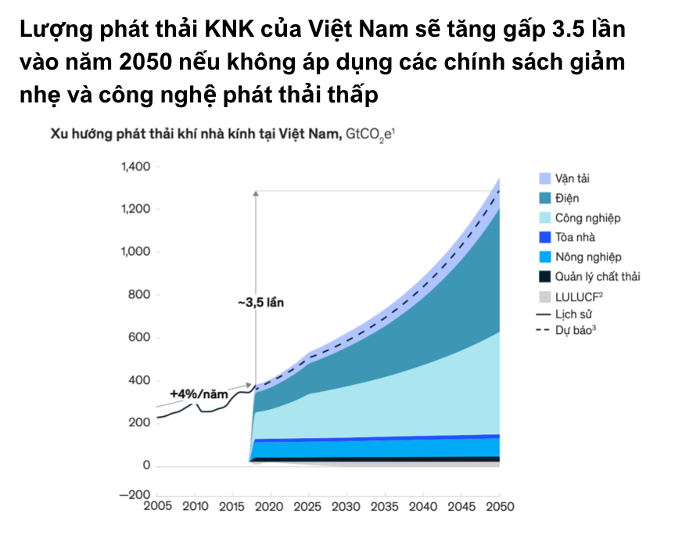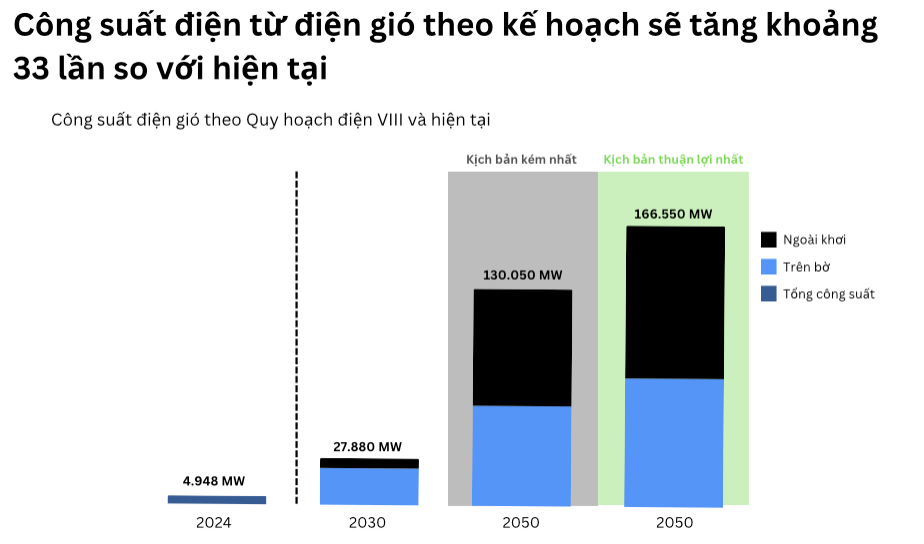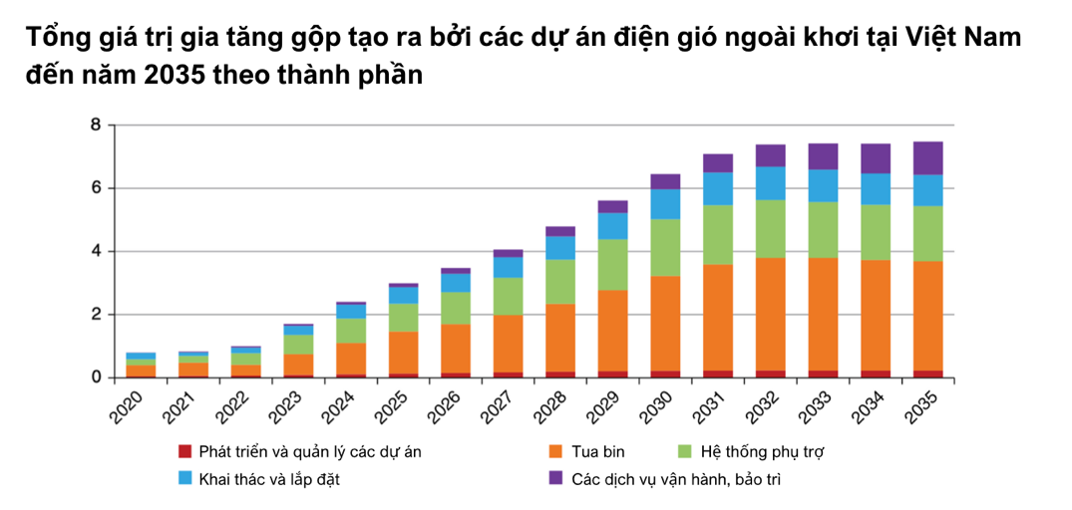Wind power is considered Vietnam's top weapon to achieve Net Zero by 2050, given its significant emission reduction potential and its capacity to drive economic and social development. Join Giant Barb to explore in-depth the potential, benefits, and challenges that this industry faces below!
Context
At COP 26 held in Scotland in 2021, Vietnam set an ambitious goal to achieve net-zero emissions by 2050 and to eliminate coal power by 2040. Fulfilling these strong commitments is particularly challenging given that Vietnam's greenhouse gas (GHG) emissions are projected to grow 3.5 times if the country does not implement emission reduction policies and low-carbon technologies.

Source: McKinsey
According to estimates, Vietnam's emissions come from various sectors of the economy, with the largest sources being Electricity and Industrial activities, each accounting for 30% of emissions. To achieve the Net Zero goal, it is essential for the Vietnamese government to focus on reducing emissions from the power sector by transitioning to renewable and environmentally friendly energy sources, such as solar and wind power. This article will focus on analyzing the picture of wind energy in Vietnam.
How wind creates electricity
The formation of wind primarily results from pressure differences in the atmosphere, influenced by factors such as temperature, pressure, air movement, and terrain. Wind power is generated by harnessing the force of the wind to turn the blades of wind turbines. The mechanical energy obtained from the turbines is then converted into electrical energy.
From the wind-to-electricity process, there are two key characteristics of wind power that we need to understand:
-
Firstly, unlike traditional electricity generation methods such as thermal power, wind energy is an unstable source and highly dependent on natural factors.
-
Secondly, effective wind power generation requires locations with abundant wind resources.
The potential to develop wind power in Vietnam
Vietnam has significant potential for wind power development, with over 3,200 km of coastline and an exclusive economic zone covering 1,395,000 km²—approximately three times the area of its landmass. The chart below illustrates Vietnam's wind power potential both onshore and offshore.

Source: McKinsey
It is estimated that Vietnam's theoretical wind power potential is around 650 GW. In comparison, Vietnam's total electricity capacity as of January 2024 is approximately 80,555 MW. In practice, according to VietData, Vietnam's total wind power capacity currently stands at just 4,948 MW. This indicates that there is still significant room and potential for expanding wind power resources in the country.
The Plan for the future of wind power in Vietnam
According to the National Power Development Plan for the 2021-2030 period, with a vision towards 2050 (Power Plan VIII), the government has outlined a robust plan to harness wind power. This plan emphasizes the intention to fully and unconditionally exploit the potential of wind power to meet domestic needs and exports.

Source: Vietdata, Vietnam’s PDP VIII
The total wind power capacity is planned to account for 18.5% of Vietnam's total electricity capacity by 2030. For 2050, under the most favorable scenario, this figure is projected to reach 29.4%, while under a less favorable scenario, it is expected to be 26.5%.
The wind power development goals outlined in Power Plan VIII are very ambitious. For instance, with a less favorable scenario of 70 GW of offshore wind power, Vietnam would account for 5-7% of the total offshore wind power capacity globally. Setting such ambitious wind power targets highlights Vietnam's efforts to combat climate change and underscores the social and economic potential of wind energy. However, translating these goals into reality is a challenging process with many obstacles. In fact, the Power Plan VII, issued in 2010, had set a target of 1,000 MW of wind power capacity by 2020, which had to be revised down to 800 MW by 2016.
Opportunities of Harnessing wind power potential
Wind power is not only a tool for Vietnam to achieve its Net Zero goals or protect the environment but also an opportunity to develop a high-value industry that offers significant economic benefits both domestically and through exports.
In June 2021, the World Bank released a detailed development plan for offshore wind power in Vietnam. Under a high-growth scenario, the plan envisions a total offshore wind power capacity of 70,000 MW by 2050—matching the lower target for offshore wind development set in Power Plan VIII. The economic benefits of offshore wind power for Vietnam's economy are forecasted as follows:
-
Employment: By 2035, offshore wind power is expected to generate approximately 700,000 full-time equivalent (FTE) jobs, with 40% of these jobs coming from the export of components produced by Vietnamese workers.
-
Gross Value Added (GVA): Offshore wind power is projected to create a total of $50 billion in GVA by 2035. Similarly, 40% of this value added is anticipated to come from exports.
-
Investment in the Supply Chain: Significant investments will flow into the supply chain, including wind turbine blades, towers, foundations, subsea cables, and potentially installation vessels. Total investment could reach up to $500 million, with most of this capital being deployed before 2030.

Source: World Bank
The forecasted benefits of offshore wind power alone highlight the positive impact this sector could have on Vietnam’s economy. If executed according to plan, it could become a billion-dollar industry that drives multiple aspects of Vietnamese life. However, Vietnam still faces numerous challenges in its development. The key challenges will be discussed in the following section.
Challenges for wind power
Lack of Clear Wind Power Purchase Mechanisms
Currently, wind power projects and companies in Vietnam can be categorized into two groups based on their electricity selling mechanisms:
Projects that commenced partial or full operations before November 1, 2021, benefit from the FIT mechanism. Under this scheme, the government purchases electricity at preferential rates: 8.5 US cents/kWh for onshore wind power and 9.8 US cents/kWh for offshore wind power, with a 20-year contract. This incentive has significantly boosted wind power projects, resulting in a surge in installed capacity to 4,126 MW, far exceeding the government’s initial 2020 target of 800 MW.
As of May 2024, 77 wind power plants fall into this category, primarily due to delays caused by external factors like the COVID-19 pandemic. These projects are facing profound challenges as they have invested heavily but either cannot sell their electricity or must sell it at lower prices. Specifically, 65 projects have submitted documents to the Electricity Trading Company to negotiate electricity prices. Of these, 56 projects have received provisional price approval from the Ministry of Industry and Trade and signed Power Purchase Agreements (PPAs) at rates equivalent to 50% of the price ceiling set by Decision No. 21/QD-BCT dated January 7, 2023. These rates are approximately 793.56 VND/kWh for onshore wind power and 907.975 VND/kWh for offshore wind power—about 41.1% and 40.8% of the FIT rates, respectively. These provisional rates are intended as a temporary solution to cover some costs while waiting for the implementation of permanent purchasing mechanisms.
Recently, the government introduced a Direct Power Purchase Agreement (DPPA) mechanism under Decree No. 80/2024/ND-CP, which allows entities with monthly consumption over 200,000 kWh to buy renewable electricity directly. However, creating widespread purchasing mechanisms for renewable energy remains a challenging and lengthy process.
The transmission system has not kept up with the development of wind power
Wind power is an intermittent energy source, unlike traditional energy sources. Therefore, integrating a large amount of wind power into the transmission system can overload a system that has long been underinvested in Vietnam. Evidence of this is the rapid growth of solar and wind projects since 2020, which exceeded the system’s transmission capacity by 2022, particularly in provinces with many such projects. The transmission system often operates at maximum capacity, leading to frequent disruptions for many projects. As a result, the National Load Dispatch Center announced at the beginning of 2022 that it would halt the addition of new solar and wind power plants for the entire year.
Challenges regarding electricity purchase mechanisms and the transmission system are the biggest issues that the government needs to address to unlock the potential of wind power. Additionally, other challenges include the impact of construction and operation on the surrounding community and technological issues, which are also matters that need attention.
Conclusion
Vietnam is a country with many favorable natural conditions for developing wind power. Successfully achieving the wind power development goals outlined in Power Plan VIII will bring extensive positive impacts on the economy, society, and environment. Vietnam will gain a new economic growth sector in wind power, address electricity shortages for development, and, most importantly, reduce the massive emissions from traditional energy sources, contributing significantly to Vietnam’s goal of reaching Net Zero by 2050. However, Vietnam needs to focus its resources, upgrade the transmission system in line with this vision, establish a solid legal framework, and support and collaborate with stakeholders to create favorable conditions and guide the development of wind power. This will allow Vietnam to fully harness the potential and opportunities that wind power offers.
GIANT BARB SCIENCE AND ENVIRONMENT JOINT STOCK COMPANY
📞 Hotline: +84 995 206 666
✉️ Email: info@giantbarb.com
🏢 Headquarter: No.07 Ton That Thuyet, Dich Vong Hau ward, Cau Giay district, Ha Noi